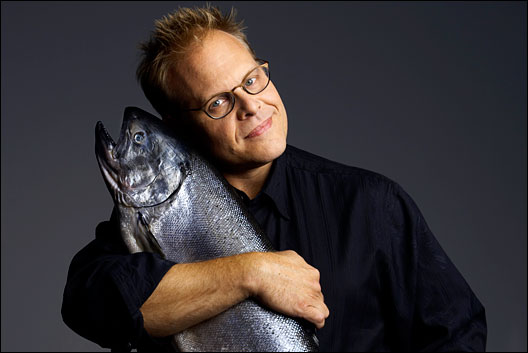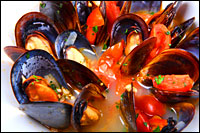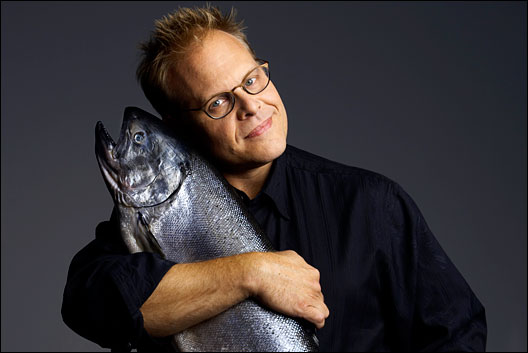
The Portola Café and Restaurant, the fine-dining venue within the Monterey Bay Aquarium, is an airy, light-filled space surrounded by windows on three sides. The soothing, understated interior showcases a breathtaking view of Monterey Bay, where one can watch otters wrap themselves in kelp while cormorants swim and dive nearby.
It is here that I have the chance to talk with Alton Brown, creator and star of Good Eats on the Food Network. Alton combines his background in film and video with his culinary training — he attended the New England Culinary Institute — to produce a show that offers clear and clever scientific explanations of everyday cooking processes.
We sit at a window-side table in a corner of the restaurant. Alton has just come from presenting awards to sustainability-minded chefs and delivering a lecture at the closing ceremony of the Cooking for Solutions conference. Although still beautifully dressed in the suit he wore for the presentation, he manages to look informal as well as dapper. Is it possible to describe someone as wearing an entire suit at a rakish angle? That’s the feeling I get when we sit down to talk. I realize how long it’s been since I’ve had occasion to use the word jaunty, but that’s the one that comes to mind when I search for ways to describe Alton.
During his lecture, Alton announced that his TV show would begin focusing on sustainability issues: how crops are grown and animals are raised. The shift in focus would be a form of penance, he said.
At the restaurant, I ask him what he meant by that. “I’ve spent the last nine years influencing what people do with food, but I haven’t taught them about the real essence of feeding themselves, and I feel that it’s high time to step up to bat,” he says. “I’ve been busy being clever, but now I want to use what credibility I may have to help people think about sustainability.”
To Serve and Protect
Alton went on to explain that his eight-year-old daughter has had an enormous impact on his life. She forces him to think about the future quality of life on the planet. He has also been thinking hard about what she should learn about the environment, he said, adding that watching his daughter engage with the world reminds him of his own experiences when he was her age. His childhood heroes were two public-television icons: Julia Child of cooking fame and Jacques Cousteau, the seafaring French ecologist/explorer.
He wants to combine what he learned from both of them by taking a “serve and protect” approach to cooking and eating. “It’s the same motto as the L.A. police department,” he said. “I think it makes sense to try to change the way food is grown and animals are raised rather than by, for example, just not eating animals. We can’t fix problems by shunning them.” In effect, he is calling for a kind of enlightened omnivorism. “I sometimes wish that Theodore Roosevelt were still around,” he said. “He believed that we can eat and care for animals at the same time.”
The first step in this revolution, Alton believes, is to examine and rework our current system of values. “We place the highest value on cheapness,” he said, harking back to a point he had made at the lecture: that while we like to think we value the lives of the animals we eat, it’s obviously not so, as is clearly demonstrated by the way that we waste animal products.
What’s Your “Chicken Moment”?
Alton stressed that people are too far removed from the foods that feed them, adding that his generation is the first in his family not to farm at least some of the food that they eat. This distance between farm and plate has forced us to accept inferior food. “A friend of ours had chickens and she gave us fresh eggs and I got addicted to them,” he said. “Once you eat fresh eggs, you realize what eggs are really supposed to taste like. Fresh eggs have deep yellow yolks and a lot of flavor.”
The experience led to an epiphany: everyone should raise hens. “There’s no reason you can’t raise chickens in the city,” he said, adding that he keeps 25 chickens at the television studio he uses in Georgia.
Chicken also played a pivotal role in his daughter’s understanding of food systems. The family was having dinner at Bolo, a restaurant owned by Brown’s Food Network colleague Bobby Flay, on a trip to New York City. Brown’s daughter was served a plate of roasted chicken. She looked at it for a while, and then declared “That’s a chicken!” She made the connection between the chicken on the plate and the chickens that populate farms and children’s books. Alton explained to her that yes, these chickens are the same as the ones from the barnyard, and that people care for them, then kill them and eat them. She was silent for a moment, then said, “I’m OK with that.”
Alton wishes everyone could experience his or her own “chicken moment” — the moment when we realize, in a visceral and undeniable way, that the animals we eat have lives, and that we are as responsible for the way they live as we are for the way they die.
Kitchen Failures and Dinner Invitations
I told Alton that one of the things that I think is wonderful about cooking is that, apart from a small investment of time and money, the stakes are generally pretty low. When you mess up, you can usually eat the mistake. I added that I purposely write about my screw-ups and failures so that readers will feel more comfortable messing around in the kitchen.
Alton picked up the theme and ran with it. “If something I cook turns out badly, I serve it anyway, even to company,” Alton said. “When I cook something that’s really awful, my daughter will spear it with a fork and hold it up and say, ‘Dad! What’s the story here?’ which I find very funny.”
I asked Alton whether, once he started being a TV chef, people stopped asking him over for dinner. “No, thankfully,” he replied. “I never criticize food. I never take anyone’s hospitality for granted. I am genuinely appreciative. I would eat a communion wafer smeared with mayo if that’s what I was offered.”
I watched as a nice young woman from the aquarium staff brought Alton two glasses of white wine and apologized for not remembering the names of each wine. “Not to worry!” Alton said as he quickly poured the contents of one glass into the other and then back again, like a mad scientist working with beakers. It was like watching an episode of his show.
Balancing Act
The topic turned to ways of inspiring people to think hard about sustainability. “People need to learn about sustainability as the need for a system in balance,” he began. “The first step is to question everything. Question different aspects of the food system, one at a time. We might not get answers right away, but non-answers are just as valuable!”
As the waves lashed outside the window, he turned his attention to the high seas. “Somebody’s got to get serious about what’s happening to the oceans.” Alton talked about illegal fishing as a form of modern-day piracy, “with fish as the booty.” He wasn’t kidding. Then he added this: “Somebody needs to sink the Japanese tuna fleet. Everyone’s willing to point the finger, but nobody’s willing to pull the trigger.”
Surprised by such a rash declaration, and wanting to present a more effective, lasting, and peaceful alternative, I asked Alton if he would be willing to crew on a Greenpeace boat. Several Greenpeace ships are currently documenting and publicizing illegal tuna fishing operations and the subsequent transfer of tuna to refrigerated mother ships (a practice that’s called, accurately yet still unbelievably, “tuna laundering”).
“Yes! Absolutely!” he answered. “Even the Rainbow Warrior?” I asked. “Well …,” he replied, laughing, “do they have any boats with better names?” (They do, the Esperanza and the Arctic Sunrise among them.)
Hey, Greenpeace, I think you have a recruit. (To see what life is like on a Greenpeace boat, read the blogs of some of the crew members.)
We finished our conversation and I returned to the halls of the aquarium, where hundreds of people were tasting wine, eating asparagus flan, sampling grilled bison, and savoring goat cheese. I tasted a few dishes and then headed back to the hotel to type up my notes, and to wonder what the future holds for Alton and for the world’s shrinking tuna population. I’ll be tuning in to the Food Network to find out.
Mojo Moulies
Recipe courtesy of Alton Brown
Alton shared with me this delicious, simple preparation for mussels (moules in French) — labeled an “excellent choice” in sustainability terms by the Monterey Bay Aquarium’s Seafood Watch.

Flex your mussels.
1 large leek, cleaned, trimmed, and chopped
Pinch kosher salt
3 tablespoons olive oil
20 mussels
1 ripe tomato, seeded and chopped
1 1/2 cups white wine
Chopped parsley
Hardware:
8-quart nonreactive, stainless steel stockpot
Metal colander or steamer insert
In the stockpot, sweat the garlic, leeks, and salt in the olive oil until softened over medium-low heat. Place the mussels in the colander and spray them with cold water to remove any excess dirt or grit. Remove any beards with a pair of needle-nose pliers.
Add the chopped tomato and the wine to the stockpot and turn the heat to medium high, and bring to a simmer. Insert the colander of mussels into the stockpot and cover. After 3 minutes, check to see if the mussels have opened. If some are still closed, cover the pot, and cook for an additional 30 seconds. Discard any unopened mussels.
Place the mussels in a serving bowl. Remove 10 mussels from their shells and add them to the stockpot. Using a stick blender or a bar blender, puree the mussels until the liquid is of a sauce-like consistency.
Pour the sauce over the mussels and garnish with chopped parsley. Serve immediately, with a loaf of crusty bread.


